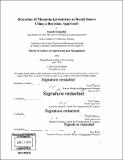| dc.contributor.advisor | Chris Caplice. | en_US |
| dc.contributor.author | Tripathy, Sonali. | en_US |
| dc.contributor.other | Massachusetts Institute of Technology. Engineering and Management Program. | en_US |
| dc.contributor.other | System Design and Management Program. | en_US |
| dc.date.accessioned | 2019-09-17T19:51:01Z | |
| dc.date.available | 2019-09-17T19:51:01Z | |
| dc.date.copyright | 2019 | en_US |
| dc.date.issued | 2019 | en_US |
| dc.identifier.uri | https://hdl.handle.net/1721.1/122257 | |
| dc.description | Thesis: S.M. in Engineering and Management, Massachusetts Institute of Technology, System Design and Management Program, 2019 | en_US |
| dc.description | Cataloged from PDF version of thesis. | en_US |
| dc.description | Includes bibliographical references (page 35). | en_US |
| dc.description.abstract | Phantom inventories result from mismatch in the inventory that is actually available at a store on the shelf and the existing inventory as per the data record at any retail store. Inventory on hand (IOH) record for each SKU(stock keeping unit) at any store is summation of on-shelf and back room inventory. Mismatch in this data impacts the product availability at a store and in turn results in lost opportunities of revenues for the store and the CPG (consumer product goods) manufacturer. A phantom inventory remains unnoticed unless an intervention such as regular shelf re-stocking, physical audit or consumer inquiry occurs at the store. However, even these interventions may not coincide with actual shelf stock out event and hence, the phantom inventory would continue to exist. This report proposes a Bayesian approach based on consecutive zero sales in the POS (point of sales system) while inventory IOH remains positive through the observation time. The daily demand is designed using a negative binomial distribution, which is used further to determine the posterior probability of phantom inventories given a specific set of consecutive days without sales of a SKU at a store. The prevalence of phantom inventories is then calculated using all the number of consecutive days without sales for each SKU store combination and is compared to a Gumbel distribution. This approach has been applied on one data set including POS and IOH data provided by a CPG manufacturer, where the prevalence was found to be 11.63%. | en_US |
| dc.description.statementofresponsibility | by Sonali Tripathy. | en_US |
| dc.format.extent | 35 pages | en_US |
| dc.language.iso | eng | en_US |
| dc.publisher | Massachusetts Institute of Technology | en_US |
| dc.rights | MIT theses are protected by copyright. They may be viewed, downloaded, or printed from this source but further reproduction or distribution in any format is prohibited without written permission. | en_US |
| dc.rights.uri | http://dspace.mit.edu/handle/1721.1/7582 | en_US |
| dc.subject | Engineering and Management Program. | en_US |
| dc.subject | System Design and Management Program. | en_US |
| dc.title | Detection of phantom inventories at retail stores using a Bayesian approach | en_US |
| dc.type | Thesis | en_US |
| dc.description.degree | S.M. in Engineering and Management | en_US |
| dc.contributor.department | Massachusetts Institute of Technology. Engineering and Management Program | en_US |
| dc.identifier.oclc | 1119555264 | en_US |
| dc.description.collection | S.M.inEngineeringandManagement Massachusetts Institute of Technology, System Design and Management Program | en_US |
| dspace.imported | 2019-09-17T19:50:59Z | en_US |
| mit.thesis.degree | Master | en_US |
| mit.thesis.department | SysDes | en_US |
